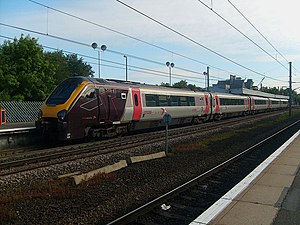British Rail Class 221
| British Rail Class 221 Super Voyager | |
|---|---|

Cross Country Class 221 No. 221129 at Durham Station
|
|

The interior of Standard Class aboard a Class 221
|
|
| In service | 12 April 2002– |
| Manufacturer | Bombardier Transportation |
| Family name | Voyager |
| Constructed | 2001–2002 |
| Number built | 44 sets |
| Number in service | 43 sets |
| Formation | 4 or 5 cars per set |
| Fleet numbers | 221101–221144 |
| Capacity | 26 first class, 162 or 224 standard class per trainset |
| Operator(s) |
CrossCountry Virgin Trains (West Coast) |
| Specifications | |
| Car body construction | Steel |
| Car length | 23.85 m (78 ft 3 in) driving end cars 22.82 m (74 ft 10 in) other cars |
| Width | 2.73 m (8 ft 11 in) |
| Doors | Swing plug at vehicle ends |
| Articulated sections | Flexible diaphragm within unit only |
| Maximum speed | 125 mph (200 km/h) |
| Weight | 227 t (223 long tons; 250 short tons) or 282.8 t (278.3 long tons; 311.7 short tons) per trainset |
| Traction system | DEMU |
| Prime mover(s) | Cummins QSK19 of 560 kW (750 hp) at 1800rpm |
| Power output | 560 kW (750 hp) per car |
| UIC classification | 1A'A1'+1A'A1'+...+1A'A1' |
| Braking system(s) | Rheostatic and electro-pneumatic |
| Safety system(s) | AWS, TPWS, TASS |
| Coupling system | Dellner |
The Class 221 Super Voyager is a class of diesel-electric multiple-unit express trains built in Bruges, Belgium, by Bombardier Transportation in 2001/02.
The Class 221 are similar to the Class 220 Voyager units, but were built with a tilting mechanism enabling up to six degrees of tilt to allow higher speeds on curved tracks, most have five coaches, and they have a different bogie design. They have a maximum speed of 125 mph (200 km/h).
Currently these trains are divided between two operators, Virgin Trains (West Coast) (20 sets) and CrossCountry (23 sets). The sets operated by CrossCountry have now had their tilt function disabled to improve reliability and reduce maintenance costs.
The Class 221s were produced as 5- or 4-coach sets. Each coach is equipped with a Cummins QSK19 diesel engine producing 560 kW (750 hp) at 1,800 rpm, driving an electrical generator which powers two motors, each driving one (inner) axle per bogie via a cardan shaft and final drive. 1,200 miles (1,900 km) can be travelled between refuellings. The coach bodies, the engines and most of the equipment of the Class 221s are the same as the Class 220s, but the bogies are very different: the Class 220 Voyager B5000 bogies have inside-frames which expose the whole of the wheel faces, while the Class 221 SuperVoyager Y36 bogies have a more traditional outside-framed bogie. Unlike the Class 220s, the Class 221s were built with a hydraulic-actuated tilting system to run at high speed around bends, though this has now been removed from the 23 sets operated by CrossCountry.
Each coach weighs between 55 and 57 tonnes, with a total train weight of 281.9 tonnes for a 5-car set (227 tonnes for a 4-car set). The trains have air-operated (pneumatic) and rheostatic brakes, with an emergency stopping distance of 350m at 60 mph (97 km/h).
Class 221 units do not have automatic sanding equipment, and instead have "one-shot" sanders which activate when all of the following conditions are met:
...
Wikipedia
